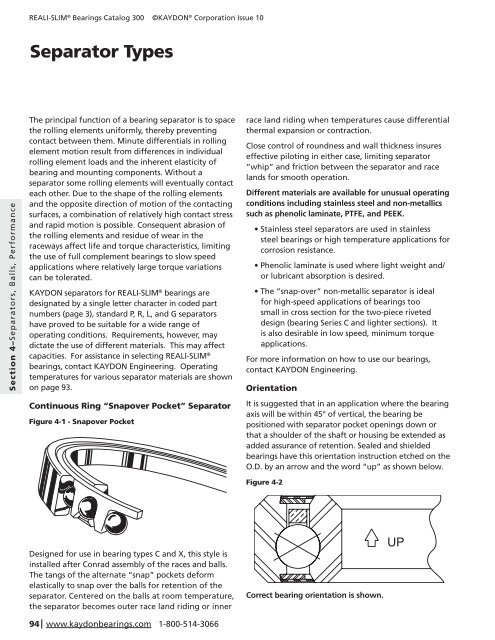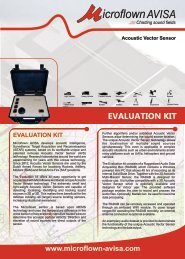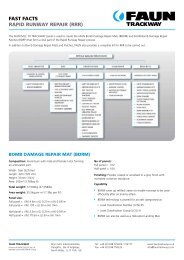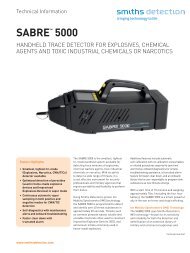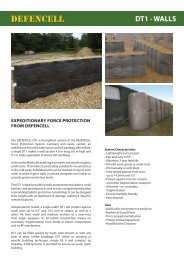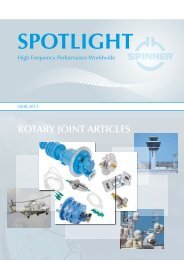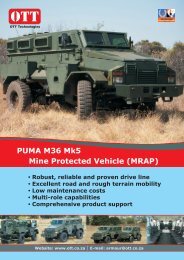Catalog 300 - Kaydon Bearings
Catalog 300 - Kaydon Bearings
Catalog 300 - Kaydon Bearings
You also want an ePaper? Increase the reach of your titles
YUMPU automatically turns print PDFs into web optimized ePapers that Google loves.
REALI-SLIM ® <strong>Bearings</strong> <strong>Catalog</strong> <strong>300</strong> ©KAYDON ® Corporation Issue 10<br />
Separator Types<br />
Section 4–Separators, Balls, Performance<br />
The principal function of a bearing separator is to space<br />
the rolling elements uniformly, thereby preventing<br />
contact between them. Minute differentials in rolling<br />
element motion result from differences in individual<br />
rolling element loads and the inherent elasticity of<br />
bearing and mounting components. Without a<br />
separator some rolling elements will eventually contact<br />
each other. Due to the shape of the rolling elements<br />
and the opposite direction of motion of the contacting<br />
surfaces, a combination of relatively high contact stress<br />
and rapid motion is possible. Consequent abrasion of<br />
the rolling elements and residue of wear in the<br />
raceways affect life and torque characteristics, limiting<br />
the use of full complement bearings to slow speed<br />
applications where relatively large torque variations<br />
can be tolerated.<br />
KAYDON separators for REALI-SLIM ® bearings are<br />
designated by a single letter character in coded part<br />
numbers (page 3), standard P, R, L, and G separators<br />
have proved to be suitable for a wide range of<br />
operating conditions. Requirements, however, may<br />
dictate the use of different materials. This may affect<br />
capacities. For assistance in selecting REALI-SLIM ®<br />
bearings, contact KAYDON Engineering. Operating<br />
temperatures for various separator materials are shown<br />
on page 93.<br />
Continuous Ring “Snapover Pocket” Separator<br />
Figure 4-1 - Snapover Pocket<br />
race land riding when temperatures cause differential<br />
thermal expansion or contraction.<br />
Close control of roundness and wall thickness insures<br />
effective piloting in either case, limiting separator<br />
“whip” and friction between the separator and race<br />
lands for smooth operation.<br />
Different materials are available for unusual operating<br />
conditions including stainless steel and non-metallics<br />
such as phenolic laminate, PTFE, and PEEK.<br />
• Stainless steel separators are used in stainless<br />
steel bearings or high temperature applications for<br />
corrosion resistance.<br />
• Phenolic laminate is used where light weight and/<br />
or lubricant absorption is desired.<br />
• The “snap-over” non-metallic separator is ideal<br />
for high-speed applications of bearings too<br />
small in cross section for the two-piece riveted<br />
design (bearing Series C and lighter sections). It<br />
is also desirable in low speed, minimum torque<br />
applications.<br />
For more information on how to use our bearings,<br />
contact KAYDON Engineering.<br />
Orientation<br />
It is suggested that in an application where the bearing<br />
axis will be within 45° of vertical, the bearing be<br />
positioned with separator pocket openings down or<br />
that a shoulder of the shaft or housing be extended as<br />
added assurance of retention. Sealed and shielded<br />
bearings have this orientation instruction etched on the<br />
O.D. by an arrow and the word “up” as shown below.<br />
Figure 4-2<br />
Designed for use in bearing types C and X, this style is<br />
installed after Conrad assembly of the races and balls.<br />
The tangs of the alternate “snap” pockets deform<br />
elastically to snap over the balls for retention of the<br />
separator. Centered on the balls at room temperature,<br />
the separator becomes outer race land riding or inner<br />
94 | www.kaydonbearings.com 1-800-514-3066<br />
Correct bearing orientation is shown.


